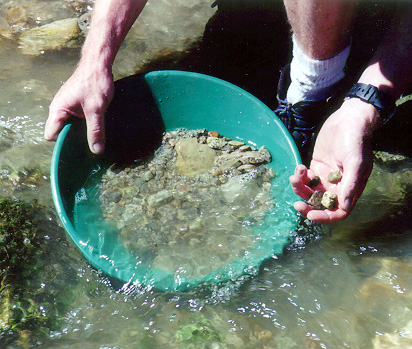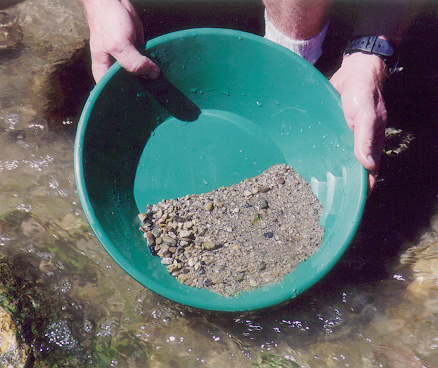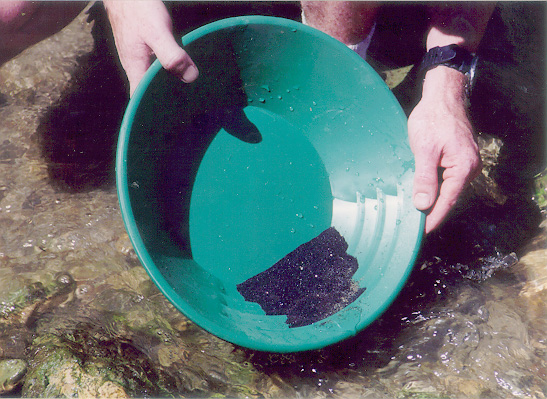NEW CLICK HERE FOR THE AMAZON PRIME PAGES!
NEW CLICK HERE TO SEND US A GIFT! A COOL IDEA TO HELP US FOR HELPING YOU!
CLICK HERE FOR THE MAIN IOWA GOLD START PAGE
NEW IOWA GOLD FORUM WHERE TO GO, BUY SELL AND TRADE, EVENTS IN IOWA
NEW!! GOLD HOW TO PAGES HOW TO BUILD YOUR OWN GEAR!!
NEW BIG GOLD HOW TO PAGES FULL OF PLANS AND TIPS AND TRICKS OF HOW TO FIND GOLD
WHERE TO FIND GOLD IN THE USA A STATE BY STATE GUIDE
TECH SPECS ON GOLD WHAT IT IS ETC.
GOLD EQUIPMENT REVIEW GEAR WE HAVE TESTED AND WHAT WE THINK OF THE PRODUCT
DETECTOR PAGES GOLD AND COINS OR TRASH AND TREASURE TIPS AND TRICKS AND HOW TO PAGES
GOLD EQUIPMENT QUICK FIXES COOL TIPS HERE AND MORE ON HOW TO SET UP GEAR AND MORE TIPS AND TRICKS
IOWAGOLD NATURE AND TRAVEL PAGES!
HOW TO PAN FOR GOLD.. AND OTHER MATERIALS
Panning Instructions |
Before you actually start to process your first pan full of material, look around for the best location for panning. Select a spot where the water is a minimum of six inches deep and flowing just fast enough to keep the muddy water from impairing your vision of your pan and a place where you can sit down comfortably. |
 |
STEP A. WASHING OFF LARGER ROCKS AND MOSS 1. Fill pan 3/4 full of gravel, then submerge it deep enough so it is just under the surface of the water. Give the pan several vigorous shakes back and forth and from side to side, but not too vigorous as to wash material out of the pan. |
2. Change from the shaking motion to a gentle circular movement, so the material starts revolving in a circle. This process will cause most of the dirt and clay to dissolve and wash out of the pan. If roots and moss surface, work them over your pan with your fingers to dissolve any lumps. Pick out the larger rocks after making sure that they are washed clean. Repeat processes 1 and 2 of step A to get the smaller rock to the surface and to cause the heavier concentrates to settle. |
 |
STEP B. WASHING OFF LIGHTER SAND AND GRAVEL 1. Hold the pan just under the water and tilt it slightly away from you. Begin to swirl the water from side to side, with a slight forward tossing motion. Take care, but with sufficient force to move the surface and the lighter gravel out over the edge of the pan. |
2. Leveling the pan from time to time and shaking it back and forth will cause the light material to come to the surface and the gold to settle to the bottom. Repeat process 1 and 2 of step B until there is only about two cups of heavier material left in your pan. This material is usually called "black sand," or "concentrate." |
 |
STEP C. WASHING OFF BLACK SAND AND CONCENTRATES At this point it is better for the beginner to raise the pan completely out of the water, leaving about an inch of water in it. Tilt the pan slightly towards you and swirl the water slowly in a circular motion to check the pan for nuggets and pieces that are easily picked out by hand. |
Then submerge the pan again in water and
repeat process 1 and 2 of step B for final concentration. This is the most critical part
of panning. Make sure this final process is accomplished with as much diligence as
possible so you do not to wash out the gold. Apply the magnet to the bottom side of the pan and move it in a small circular motion with the pan slightly tilted. This will swiftly isolate the gold from the black sand. |
 |
PANNING HINTS. When using a steel pan, make sure to remove all the oil from the pan before you use it. The most common way is to "burn" it over the coals of a campfire using extreme caution. The pan is heated to a dull red glow, then dunked in water. This not only removes the oil but also gives the pan a dark blue hue, which makes the gold easier to see. If any oil is left in the pan, it will cause the fine gold to float, making separation impossible. |
Another secret to speed up the final
steps is to keep a small squeeze bottle of detergent close at hand. A couple of drops in
the pan during the last separation will break the surface tension of the water and speed
up the operation considerably. An item that is considered a necessary part of a panners equipment is a panning sieve. The sieve sets over the pan and can screen or classify the larger cobbles, making the panning process much easier. The sieves are available in sizes from 1/4 of an inch (4mesh) to a 100 mesh size screen. The gold pan sieves are most popular with the medium size pan and are available in most prospecting stores that sell gold recovery equipment. |




![[Most Recent Quotes from www.kitco.com]](http://kitconet.com/images/quotes_7a.gif)